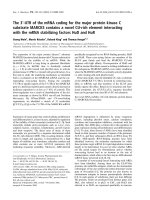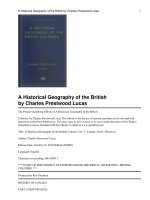Lesson Week 3: Geography of the UK
Bạn đang xem bản rút gọn của tài liệu. Xem và tải ngay bản đầy đủ của tài liệu tại đây (3.41 MB, 60 trang )
Week 3: Geography of the UK
Company
Logo
Contents
1
England Geography
2
Scotland Geography
3
Wales Geography
4
Northern Ireland Geography
2. England Geography
Topography
England’s Quick Facts
Area: 130,423 sq km
Population:
51,460,000
(2008,
statistic.gov.uk)
Capital City: London
Major Cities: Birmingham, Leeds,
Liverpool, Manchester, Sheffied
Official Language: English
Currency: Pound Sterling (£)
Highest point: Scafell Pike (978 m)
Longest River: The Thames (346 km)
Largest Lake: Windermere (14.7 sq
km)
Topography
• Is the largest of the countries comprising the island of
Britain (covering about two-third of the island).
• Can be divided into two major regions:
the highland zone of hills and mountains in the
North and West.
the lowland zone of rolling plains in the South and
East.
Topography
• The highland zone including the Pennine Chain of
mountains (the backbone of England), is a massive
upland area (160 miles – 260 km).
• Is made up of several broad, rolling, windswept
moorlands separated by deep river valleys.
• Generally, the Highland is cooler than the Lowland, and
gets more rainfalls and less sunlight.
• The soil is too thin and stony, with hard rock formation
below the ground.
Topography
• The lowland zone contains mostly rolling plains,
receives less rain and more sunshine than the
highland zone, and the soil is fertile.
• Most of the region is less than 150m (500ft) above
the sea level.
• Has been extensively inhabited, farmed and
grazed for thousands of years.
• Most of Britain’s population lives densely packed into
the lowland zone.
Climate
• The overall climate is called Temperate maritime.
• Mild with temperatures not much lower than 0oC in
winter, and not much higher than 320C in summer.
• Has four seasons:
Spring: March to May
Summer: June to August
Autumn: September to November
Winter: December to February
Images of England
• Is the most important river in
the southern England.
• Is the main source of the
water supply of London.
•
The
part
immediately
of
below
the
river
London
Bridge is called the Pool, part
between the bridge and the
Blackwall is called the Port
River Thames
Big Ben
• Is the great bell in the clock
tower on the eastern end of the
Houses of Parliament in London.
• The booming 13.5 ton bell first
rang out in 1859.
• Officially Big Ben is only the
name of the biggest of the 5
bells in the clock tower (St.
Stephen’s Tower)
Westminster Abbey
• Is the most famous church in Great
Britain.
• Located in London, officially known as
the Collegiate Church of Saint Peter in
Westminster.
•
Was
built
between
11th
and
19th
centuries.
• In the main church of the abbey there
were the tombs of famous citizens – the
poet Geoffrey Chaucer, the physicist Isaac
Newton,
and
the
naturalist
Charles
Houses of Parliament
•
Also
called
New
Palace
of
Westminster, is the seat of the British
legislation, on the East bank of the
River Thames in London.
• Was built from 1840-1860, after plans
by Sir Charles Barry, on the site of the
Palace of Westminster which was
largely destroyed by fire in 1834.
• Cover an area of more than 3
hectares and contain 1100 apartments,
100 staircases, and 11 courts.
Bobbies
•
Bobby
(nickname
for
policeman) is named after
Sir
Robert
politician
Peel,
who
the
created
London’s police force in the
19th century.
• Bobby is familiar form of
“Robert”.
Double – Decker Buses
• Can be seen all over Britain, but only red ones are seen in
London.
• Buses in London are not as popular as the Tube because
they get stuck in traffic.
The Rose
• The national flower of England.
•
Has
England’s
been
adopted
as
emblem since
the
Wars of the Roses – civil wars
(1455 – 1485).
• The civil wars between the
house of Lancaster (emblem
was a red rose) and the royal
house of York (emblem was a
white rose)
The Oak
• Is sometimes depicted as the
traditional tree of England
partly for its connotation of
strength and endurance.
partly for its royal associations.
• Is regarded as the “monarch of
the forest”.
3. Scotland Geography
Topographic map
Regions and Cities
Scotland’s Quick Facts
Area: 78,789 sq km
Population: 5,222,100 (2010 estimate)
Capital City: Edinburgh
Major Cities: Aberdeen, Dundee, Glasgow, Edinburgh, Stirling.
Official Language: English / Scottish Gaelic (1.4%)
Currency: Pound Sterling (£)
Highest point: Ben Nevis (1,343 m)
Major Rivers: The Clyde, The Dee, The Don (The longest: Tay- 188
km)
Major Lakes: Loch Linnhe, Loch Fyne (Sea Lakes), Loch Ness
National emblems: St. Andrew, bluebell, thistle.
Regions
Has 3 fairly clearly-marked regions:
The Southern uplands (north of the border with England):
small towns, quite far apart from each other, economy
depends on sheep farming.
The Central plain (further north): riff valley, relatively low-
lying, economy includes coal and iron, 80% of the population.
The Highlands (lie to the north and west): mountains,
deep valleys, and numerous small islands, the North Sea oil
industry is the main economy.
Major Cities
Glasgow
Edinburgh
Glasgow
• Is a third largest city in
Britain.
• Associated with heavy
industry
•
Has
a
strong
artistic
heritage.
•
In
1990,
was
the
European City of Culture.
• Over the centuries, has
received many immigrants
from Ireland
Edinburgh
• Is half size of Glasgow.
• Is the capital city of Scotland.
• Has comparatively middleclass image.
• Associated with scholarships,
the law and administration.
•
Has
many
fine
historic
buildings
=> Is called “Athens of the
North”
Weather and Climate
• Is subject to the moderating influence of the surrounding
seas.
Extreme seasonal variations are rare
• Temperate winters and cool summers are the
outstanding climatic features.
• In the western coastal region, conditions are somewhat
milder than in the east (subject to the moderating effects
of the Gulf Stream).
The Thistle & The Bluebell
The Thistle
The Bluebell









